
UTAR Faculty of Medicine and Health Sciences (FMHS) Department of Physiotherapy and the Department of Population Medicine collaborated with the Division of Community and International Networking (DCInterNet) to organise the 2022 UTAR Industry-Academia Dialogue, themed ‘Workspace Compatibility: Handling Work-Related Injuries and Diseases’, via Microsoft Teams on 25 February 2022.
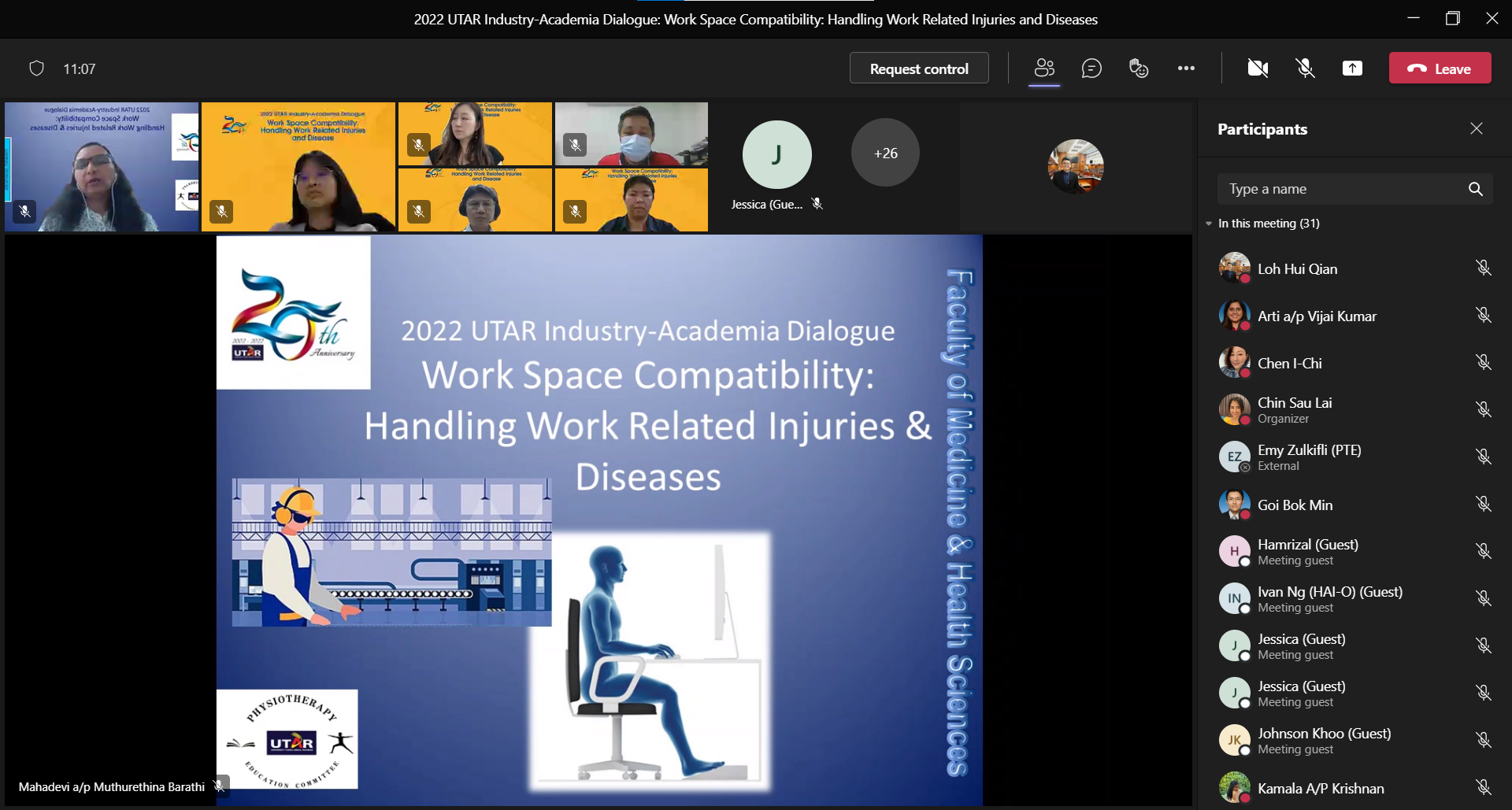
UTAR Industry-Academia Dialogue themed Workspace Compatibility: Handling Work Related Injuries and Diseases
The speakers were FMHS Department of Physiotherapy lecturer Wong Che Loong and FMHS Department of Population Medicine Clinical Prof Dr Retneswari S. Masilamani. The webinar was moderated by FMHS Department of Physiotherapy senior lecturer Mahadevi M. Barathi.
The webinar aimed to provide a platform for participants to learn and understand work-related injuries and diseases in the industry as well as to propose solutions to the industry via industry-academia collaborations, including human capital development, research collaborations and consultancies. Besides, it also aimed to give an outline of how work-related injuries and diseases can be managed and reduced, whilst improving the quality of life of the workers, reducing costs for employers and improving productivity.
Gracing the webinar with an opening remark was UTAR Vice President for Internationalisation and Academic Development Ir Prof Dr Goi Bok Min. “Welcome to the 2022 UTAR Industry-Academia Dialogue session, themed ‘Workspace Compatibility: Handling Work-Related Injuries and Disease’. Thank you for joining us. Your participation today brings significance to the event as we dialogue on a common interest and pave way for establishing potential industry-academia collaborations. I would also like to thank the speakers for sparing some time to share with us their expertise and experiences on workspace compatibility today. It will provide them a good learning platform to learn work-related safety and health, which includes bringing to light its current and future guidelines as well as its predicament and how to handle it.”
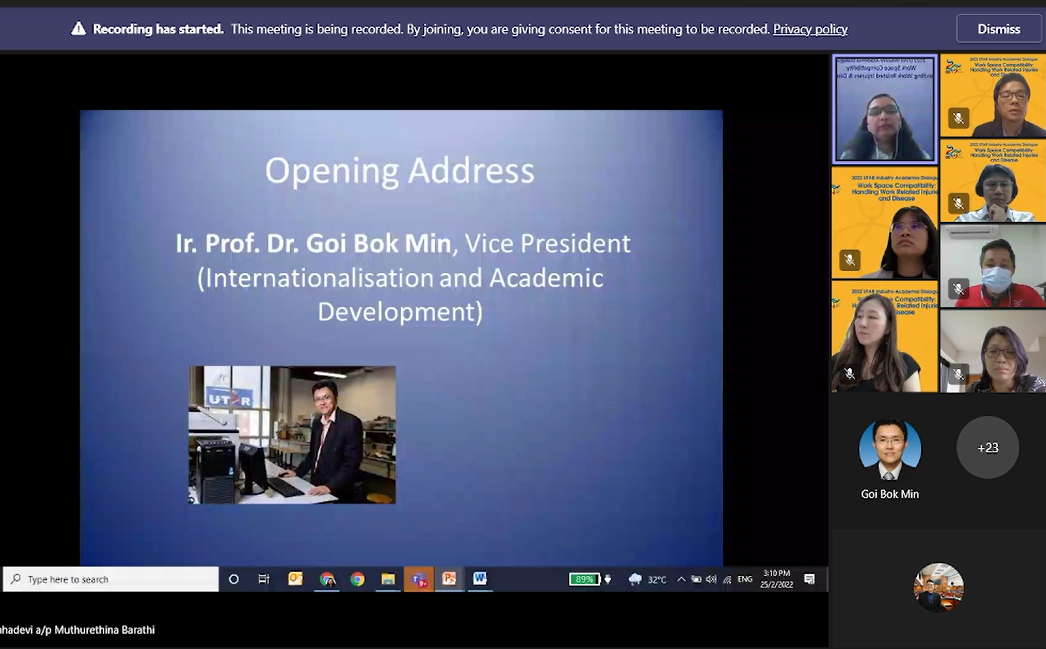
Prof Goi delivering his opening remark
The talk consisted of four sessions. The first session titled Introduction to Work-related Injuries and Diseases – Are you at Risk? was presented by Wong whereas the second session titled Biological, Chemical, Psychosocial and Physical Hazards and Associated Work-related Diseases was presented by Prof Retneswari. Wong presented the third session titled Work Design Assessment and Employee Training: To Reduce Hazards, Injuries and Legalities and Prof Retneswari presented the last talk session titled Laws in Malaysia – Legislation and Compensation.
Wong began his first talk by explaining work-related injuries and diseases. “According to Workplace Health and Safety Queensland 2021, work-related injuries can include physical injuries, psychological disorders, diseases or even death that caused by the occupation. The injuries include musculoskeletal disorders, work-related diseases from biological agents, stress and mental health disorder, skin diseases and work-related cancer,” said Wong.
He further explained, “Recently, the workers have been facing new risky exposures such as prolonged working hours, poor workstation design at home and poor posture due to the implementation of work from home during the COVID-19 pandemic. Many were suffering from neck and back pain due to poor posture and working whole day in front of the computer. Other injuries during work can happen due to manual handling, excessive forceful exertions, highly repetitive motions with short work cycles, vibration related to whole-body or segmental, mechanical stress caused by working positions or operation of tools and equipment, high levels or surrounding noise, extreme temperatures, work from heights, machine operation as well as poor postures of the neck, trunk and extremities.”
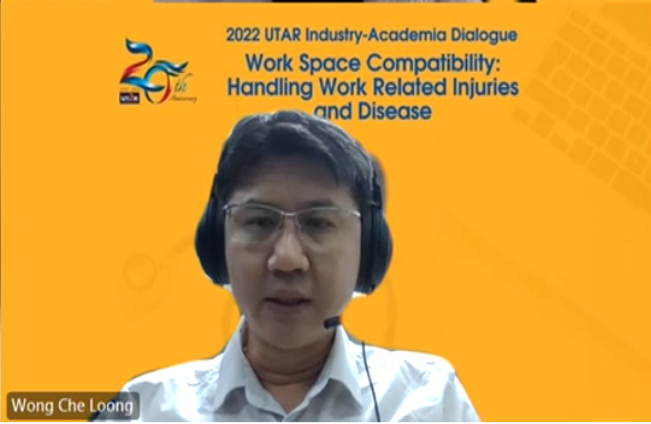
Wong during the webinar
Prof Retneswari, on the other hand, spoke about workplace hazards and risks. She said, “A hazard is a potential source of harm or adverse health effect on a person or persons, while a risk is the likelihood of a person being harmed or suffering adverse health effects when exposed to a hazard. Physical hazards refer to noise, poor lighting, exposure to cold or heat, etc; chemical hazards refer to chemical spills, insecticide sprayers and chemical mixing in laboratories; biological hazards refer to the blood which contains bacteria or viruses, prick by the needle in clinical waste and germs in laboratory specimens; psychosocial hazards involve sexual harassment, meeting deadlines and work conflict, and ergonomic hazards take place due to poor posture and weight of an object as well as repetitive work. I observed that many chairs and tables in the office are actually not suitable for work and bad for our back.”
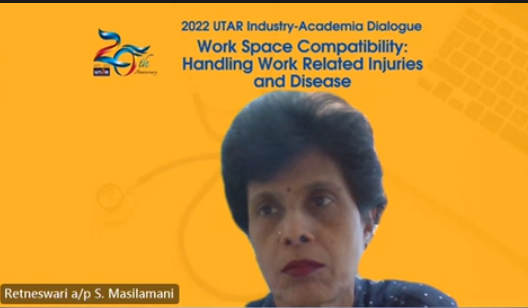
Prof Retneswari during the webinar
Speaking at the third session, Wong said, “Occupational Safety and Health (OSH) assessment and training help to create a balance between labour protection, productivity and economic growth. It also improves employee performance as well as upskill the employee for safety. The OSH Assessment consists of risk assessment, risk control measures and hazard identification. In the assessment of the workstation, for example, we will monitor the desk height, the height and type of monitor, placement of keyboard, the use of a mouse, sitting posture and also the work-rest pattern (working routine). We will also do practical skills or workplace modification for both the employer and employee.”
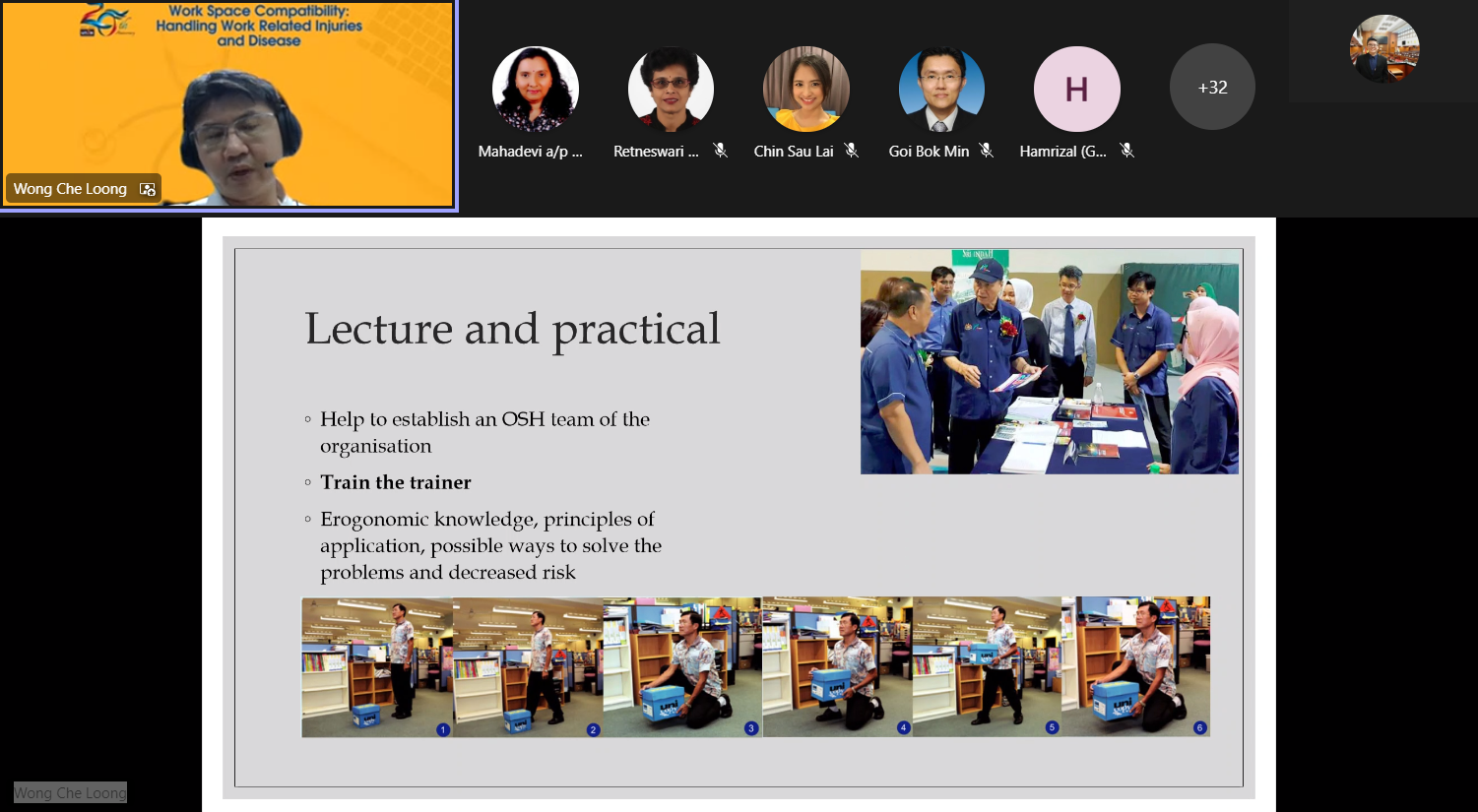
Wong explaining OSH assessment and training
According to Prof Retneswari, the custodian of occupational safety and health in Malaysia is the Department of Occupational Safety and Health (DOSH), under the Ministry of Human Resource, Malaysia. Prof Retneswari explained “The worker’s compensation is handled by Social Security Organisation (SOCSO). The main function of SOCSO is to provide social security protection to employees and their dependents through the Employment Injury Scheme and the Invalidity Scheme. The Employment Injury Scheme and the Invalidity Scheme allow SOCSO to provide free medical treatment, facility for physical or vocational rehabilitation and financial assistance to employees if the accidents or diseases have reduced their abilities to work or rendered them incapacitated. If an employee dies, his or her dependents are provided for financially through pensions. The foreign workers and self-employed individuals are only eligible for the Employment Injury Scheme.”
“It is important to notify DOSH systematically on the cases of accidents, dangerous occurrence, occupational poisoning and occupational disease because every organisation needs healthy workers to maintain productivity,” said Prof Retneswari. She also showed participants the forms required to be filled in when doing the report and sending notification to DOSH.
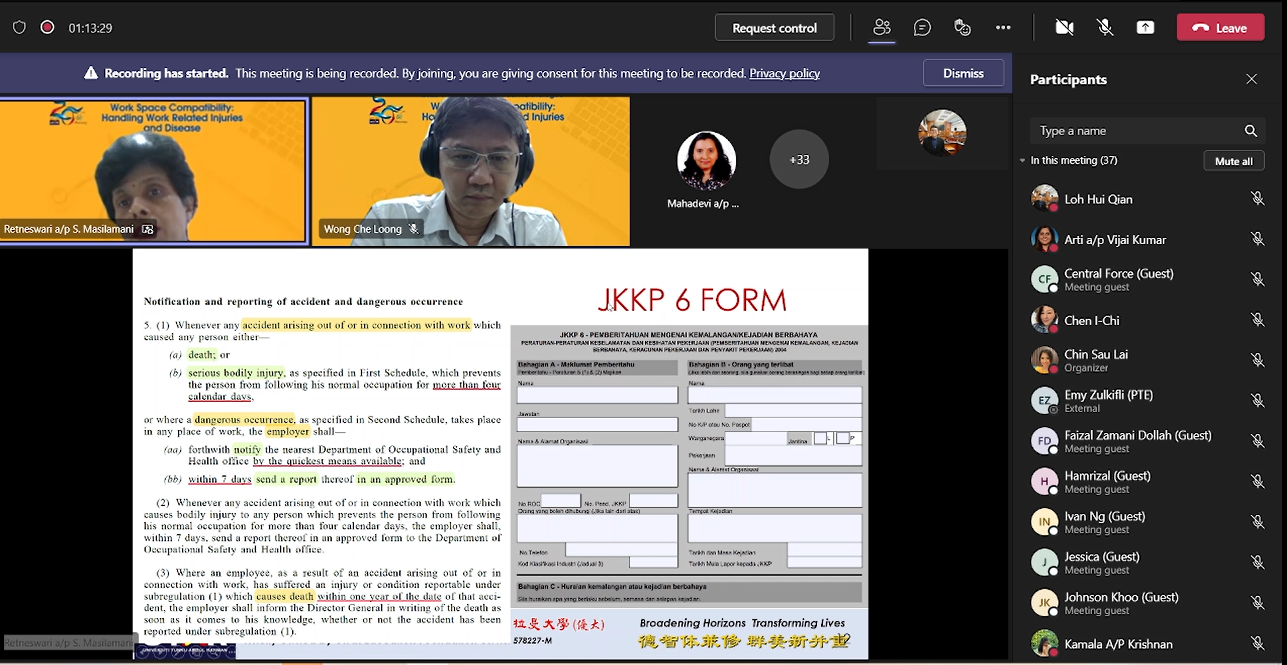
Prof Retneswari displaying the forms that need to be filled in when doing the report
After the talk sessions, UTAR DCInterNet Director Assoc Prof Dr Lai Soon Onn was invited to introduce the UTAR Industry-Academia Collaboration Initiatives.
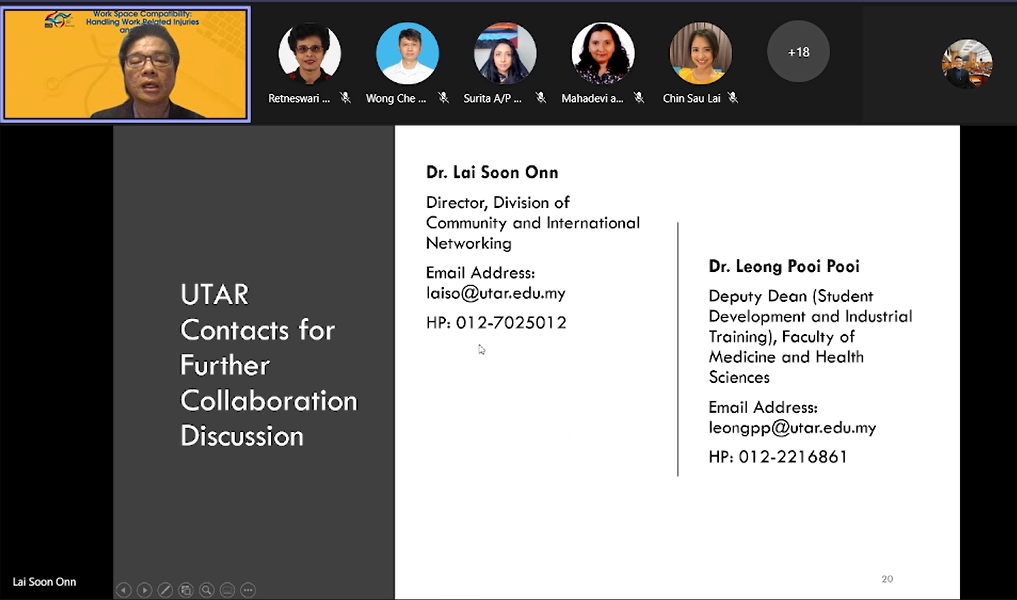
Dr Lai providing UTAR contacts to discuss further collaboration
The event concluded with a closing remark delivered by FMHS Department of Pre-clinical Sciences Deputy Dean for Student Development and Industrial Training Assoc Prof Dr Leong Pooi Pooi. She thanked all the participants for the attendance and said, “I hope after listening to all the sharing by our experienced speakers, you can get some ideas about work-related injuries and diseases. I’m also proud to share that our Department of Human Resources has set up a physiotherapy department at Sungai Long Campus to provide free services to UTAR students and staff. If you are interested in setting up a physiotherapy department at your organisations, please contact our Department of Human Resources.”

From left: Dr Lai and Dr Leong during the webinar
© 2022 UNIVERSITI TUNKU ABDUL RAHMAN DU012(A).
Wholly owned by UTAR Education Foundation (200201010564(578227-M)) LEGAL STATEMENT TERM OF USAGE PRIVACY NOTICE